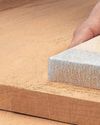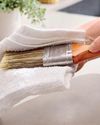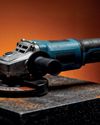FLOORING FIXES
The Home Handyman
|May/June 2023
Your floors are one of the first things people notice when they enter your home, so if you have a crack, burn or some damage, Y it is hard to hide. In this issue we'll tell you how to get your flooring back to its best, whether it is laminate flooring, tiles, or carpet
-

How to replace a laminate floorboard in the middle of a floor
When a board sustains damage in the middle of a laminate floor, you have two options for replacing it. One is to disassemble the floor down to the damaged board, replace the board and reassemble the floor. The other option is to cut out the damaged board and glue in a replacement.
Removing a damaged board
1. Draw a line down the centre of the damaged board using a straightedge and pencil. The line should span the length of the board.
2. Set the cutting depth of a circular saw blade to 3mm more than the thickness of the boards. If the subfloor is concrete, set the depth exactly equal to the board thickness.
3. Plunge the blade into the line near the centre of the board and cut toward the one end. Stop cutting when the blade reaches the edge. Pull out the saw, reverse direction and cut to the same point on the other end. Finish the cut on either end of the board by tapping along the cut line with a hammer and chisel.
4. Drill a 12mm hole at each corner of the board. The hole should be 12mm from both edges that form the corner.
Draw a line at a 45-degree angle from each hole toward the cut line in the centre.
5. Plunge the saw into the centre of the board and cut along each 45-degree line, stopping at the hole in the corner. This cutting procedure creates four triangular pieces that you can pry loose from the ends.
6. Lift the pointed end of each triangle with a pry bar and pull the triangle toward the centre of the board with pliers.
Remove it when it snaps loose. When you have removed all four triangular pieces, pry out the two centre pieces.
Installing a replacement
Denne historien er fra May/June 2023-utgaven av The Home Handyman.
Abonner på Magzter GOLD for å få tilgang til tusenvis av kuraterte premiumhistorier og over 9000 magasiner og aviser.
Allerede abonnent? Logg på
FLERE HISTORIER FRA The Home Handyman

The Home Handyman
KEEP YOUR HOUSE CRITTER FREE
With winter fast approaching, outdoor critters seeking to regulate their temperature are trying their best to get inside. Ants, spiders, moths, mosquitoes, fruit flies, stink bugs, termites, silverfish, and ladybugs, to name a few, can easily make their way into homes, and once they've settled in, it's often hard to get them out.
6 mins
Jul/Aug'25

The Home Handyman
SECRET HIDEOUTS
We all have things we would prefer to keep out of plain sight - family heirlooms, wedding rings, expensive jewellery, medicines or even weapons. Sometimes we just want to keep household items hidden in order to declutter a space. Whether you want to hide items for safety or financial reasons, or simply want to keep your bedroom tidy, there are a few clever storage ideas that could help you out.
2 mins
Jul/Aug'25

The Home Handyman
ABRASIVES DEMYSTIFIED
Abrasive materials are indispensable in countless industries, from woodworking and metal fabrication to automotive repair and electronics manufacturing.
3 mins
Jul/Aug'25

The Home Handyman
THINNERS VS. TURPENTINE
If you've ever finished a painting or staining job and been left wondering how best to clean your brushes, you're not alone. One of the most common DIY questions is: Should I use thinners or turpentine to clean my brushes? The answer depends on the type of paint or coating you've used. Using the wrong solvent can damage your brushes, or worse, make the cleaning job even harder.
2 mins
Jul/Aug'25

The Home Handyman
KEEP THE COLD OUT
Did you know that homes in South Africa are either insulated to a poor standard, compared to European nations, or have no form of insulation at all. In 2011 our National Building Regulations made it compulsory to fit thermal insulation in new buildings and additions to building structures.
5 mins
Jul/Aug'25

The Home Handyman
ANGLE GRINDERS — MASTERING THIS VERSATILE TOOL
When it comes to versatile tools in a DIYer's arsenal, few can match the power and practicality of the angle grinder.
2 mins
Jul/Aug'25

The Home Handyman
KITCHEN CARE – MAINTENANCE TIPS FOR KEY AREAS
The kitchen is the heart of the home where meals are made, memories are shared, and chaos sometimes reigns. But like any hardworking space, your kitchen needs regular maintenance to keep it functional, safe, and looking great.
2 mins
Jul/Aug'25

The Home Handyman
Separating Fact from Fiction
Maintaining your home can be a daunting task, especially with the plethora of DIY tips and tricks floating around the internet.
2 mins
Jul/Aug'25

The Home Handyman
SEALANTS SIMPLIFIED: WHAT TO USE AND WHERE
Whether you’re tackling a weekend DIY fix, remodelling your home, or involved in large-scale construction, sealants are a silent hero that play a vital role in creating watertight, airtight, and secure finishes.
3 mins
Jul/Aug'25

The Home Handyman
COMMON FRIDGE/FREEZER FAULTS
Your fridge freezer is one of the hardest-working appliances in your home, so when it stops performing as it should, it can cause major inconvenience. The good news? Not every fault means an expensive call-out or a trip to the shops for a new one. In many cases, you can fix the issue yourself with a little know-how and a few basic tools.
3 mins
Jul/Aug'25
Translate
Change font size

